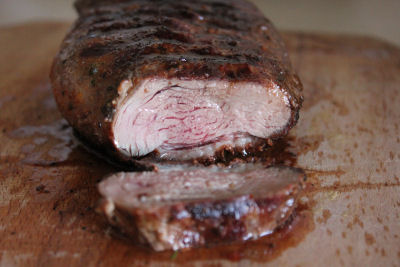
Good Cooking since 1995
Grilled Duck Breast

Patience is a must with this dish, don't get the grill too hot!
Convert the recipe![]()
Works in most Browsers
more info:
Duck breasts are relatively hard to find at a super market, but specialty meat shops often have them. You might also consider shopping online, where you certainly can find them but more often than not, they will have been frozen at some point in time. They will require overnight shipping which will add to the cost. A few supermarkets sell a brand from Canada called Brome Lake Duck which are excellent! Expect to pay $10.00 a pound or more for fresh breasts. Another choice would be to buy a whole frozen duck and bone it out, separating the breast from the legs. If you do this, expect a considerable amount of messy work and a smaller portion of breast meat because whole ducks often weigh in at 5-6 pounds whereas ducks raised just for breasts come in around 8-9-10 pounds. The ducks are different breeds but you can be assured that the meat of either tastes the same. An excellent online shop is D'Artagnan http://www.dartagnan.com/ The Moulard Duck Magret, a half breast weighing at about 8 ounces costs $14.99, this comes in at $30 a pound plus shipping.
For many years the idea of sautéing or grilling a duck breast remained a French culinary item. The rest of the world roasted duck, such as the famous Peking Duck and even the simple roast duck with a fruit sauce such as made with oranges or cherries. Roast the duck whole seasoned with salt and pepper just as you would a chicken except at a higher temperature of 400 degrees to render out from the skin more of the fat. Duck roasted this way is cooked well done, has a crisp skin, is very tender, and delicious. On the other hand a sautéed breast can be cooked rare, medium-rare or whatever doneness you like. A few things need to be done to the breast so it comes out tender. First the breast needs to be well trimmed of sinew (called silver skin in the restaurant world). Then if you cook the breast with the skin on, it needs to be scored with a very sharp knife through the skin and just under the skin into the meat below to pierce through the silver skin on that side of the breast. Often this is done with a razor blade so that you create a cross hatch mark one quarter of an inch apart from each successive cut. Once done, you can think about marinating the breast anyway you like but it's not necessary, salt and pepper sprinkled on during cooking works well. Cooking it requires attention and some skill; also you have to watch out for spattering fat. The preferred method is a French technique where you actually fry the breast in some fat and only cook it on one side like a sunny side-up egg. Because you have scored the breast, most of the fat cooks out of the skin leaving it very crisp and leaves the breast rare. If you like the breast cooked more, and then you just turn it over to the other side, like a steak. In our recipe after we do the "fry" or sear we will finish cooking the breast on a grill with a wood and charcoal fire. The last step before eating is to let it rest a few minutes before slicing; you see, if it comes directly off the grill to the plate and you cut it, it will "bleed" out the juices to the plate and the breast won' t be as juicy as it could be. This method of resting is an important technique used in professional cooking and is used a lot with steaks and roasts, for that fact it is a good thing to do with anything you cook...braised, fried, sautéed, whatever. So now you know how a chef does it and you can do it too. With practice you will have developed a new skill! Missing from this advice is what sauce to serve with and how to serve the breast, either whole or sliced; that is whether you slice it in the kitchen and plate it or serve the whole breast and it's cut as you eat it. Remember that for the sauces, simple is better so you can still taste the duck over the sauce. This is true with whatever you serve a sauce with. Here is a very simple and very nice one made from currant jelly regularly found in supermarkets. In a small pan, reduce one cup of Cabernet Sauvignon wine to 1/4 cup, over medium heat. When reduced, add 3/4 cup of currant jelly and let it dissolve over low heat and then bring it to a slow boil, season with salt and pepper as you like. Turn off the heat, let it cool just a little and then whisk in 4 tablespoons of butter, melting it all, without putting the pan back on the heat. Raspberry, apricot, orange marmalade works too, but with lighter colored jams and jellies use Chardonnay so you don't alter the color of the fruit in it.
